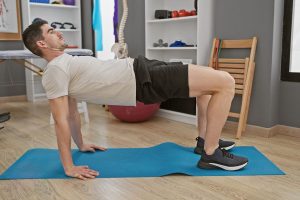Exercise can be a bewildering topic, and it draws different images into our minds depending on our backgrounds, what we’ve heard, and what our doctors, coaches, spouses, and friends have told us over the years. Many of us “used” to exercise … (remember cross country back in high school?) … but if we’re in the statistical majority, we’ve let ourselves slip over the years.
Luckily, the US Department of Health and Human Services has been putting out information intended to guide our exercise decisions, and to mitigate our risks of some of the most common health pitfalls. The guide takes the approach of utilizing a weekly volume format, aka how much exercise per week is appropriate for adults.
This will be a somewhat long article, so we want to provide the following hyperlinks for you. The main purpose of this article is to discuss the Physical Activity Guidelines for Americans, 2nd Edition and provide you with some practical suggestions for how to implement them.
Table of Contents
- 4 Common Myths About Exercise
- Physical Activity Guidelines for Americans
- How to Structure Your Exercise Plan
- Next Steps
Let us start by saying that if you already exercise, good for you! You know what forms of exercise you like and don’t like, and you are engaging in regular physical activity. We hope you can find the guidelines in this article useful in continuing to tailor your routine!
4 Common Myths About Exercise
First, let’s address some of the common sticking points people have with starting an exercise routine:
Myth #1: Exercise needs to be painful and hard.
At a 2019 seminar, Jeff Petersen (our owner) threw out a tongue in cheek question to the audience. “What’s the best part of exercise?” he asked. More than one person in the crowd proudly beamed, “when it’s over!” A few of us in the back chuckled, but this response is indicative of one of the most pervasive myths about exercise – that it must be hard and difficult in order to be productive.
The Truth: We would suggest that it’s exactly the opposite. Exercise should be somewhat challenging, enjoyable, and geared towards making slow, easy, and measurable progress over time.
With the proliferation of programs with names like “Insanity” and “Beast Mode,” it’s not hard to see where this misconception comes from. Even the names of the programs leave us with images of young men and women lying in pools of their own sweat begging for mercy. Hopefully this is not what you consider productive exercise. We don’t either.
Bouts of extreme exercise (repeated maximal or near-maximal efforts for an hour or more) can produce excessive soreness (especially in the first 3-4 weeks of training), psychological burnout, and (potentially) increase injury risk.
Additionally, studies have shown that extreme bouts of exercise (typically longer than 1 hour or above 60% of maximum oxygen uptake) can actually hinder our progress through the excessive release of the hormone cortisol (the stress hormone), which is catabolic and inhibits our bodies’ effectiveness at making progress through exercise.
Myth #2: If I miss a day or a week of exercise, I will lose all my progress
This myth is indicative of an “all or nothing” mentality that so many of us fall prey to when we exercise. Think of the classic New Year’s resolution blunder – between January 1st and January 7th, we work out 6 times. By the second week of January, we are so worn out from overdoing it the week before that we skip a couple of workouts, and before you know it, we’ve stopped exercising completely after three weeks. By February we’ve forgotten all about it. We’ve all been there.
The Truth: The truth is far simpler than we want to make it and this topic has been studied ad nauseum. Here are three examples:
- This 2011 study reported no significant differences in skeletal muscle or strength between a group of individuals who trained for 15 weeks straight, and another group of individuals who trained for 6 weeks, took 3 weeks off, and trained for another 6 weeks (15 weeks total). Take a moment and let that sink in.
- Another study reported that reducing our exercise level to 1/9th of its original volume was enough to maintain fitness levels for up to 32 weeks – a whopping 7 months!
- Similarly, another study reported that it took three weeks, on average, to begin losing skeletal muscle due to inactivity.
All of this is to say that – taking a week off for a vacation or skipping exercise for a day due to busyness is not the end of the world. Far from it!
We only really “lose” our progress when we stop completely. I’m reminded of an old exercise adage that says, “our bodies adapt to what we do MOST of the time.” The reality is that we have a lot of wiggle room – if we do everything right 80% of the time, we’ll still get all the health benefits of exercise that we are seeking.
Myth #3: I am to old to exercise!

This is an interesting one, as an argument could easily be made that exercise is more important the older you are. Take the following two CDC statistics into consideration:
- Fact #1: The CDC reports that the leading cause of death in the United States is heart disease – a condition whose risk is significantly lowered by basic behavioral changes such as reducing alcohol consumption, improving diet, quitting tobacco, managing stress, and (you guessed it) getting regular cardiovascular exercise.
- Fact #2: The CDC reports that the third leading cause of death in the United States is “accidents” – unintentional injuries such as falls. Recent research suggests that many of these accidents are linked to a condition known as sarcopenia, wherein adults over the age of 40 experience a 3-7% loss of skeletal muscle mass each decade until death. How do we combat sarcopenia? Again, you guessed it – by consuming adequate protein and engaging in regular resistance training two or more days per week.
Some people seem to insist that the day you hit the age of 41 you are doomed to a life of achy joints and diminishing usefulness. Not only is this an extremely depressing conclusion, it’s simply not true.
The Truth: We’re too old NOT to exercise. Continuing to lift over 40 and beyond is one of the most proven methods of improving our quality of life and health as we age. By adhering to a simple, regular routine of cardiovascular training and resistance training, we mitigate our chances of two of the three leading causes of death in the United States.
Myth #4: Gardening [or insert other general “moving around” activity here] is enough
There are two common categories of people who feel that their regular lifestyle negates the need for exercise:
- Group 1: Those who engage in regular “moving around” activities (such as gardening, or walking to get the mail every day), and
- Group 2: Those who say that their active job (such as construction) is enough physical activity.
The Truth: The first point is simple enough to make. Remember earlier when we said that exercise should be somewhat challenging and provide measurable progress over time? I don’t know anyone who measures the intensity, duration, and progress of their gardening … do you? The problem with this argument is that (1.) the duration of the activity is usually grossly insufficient and (2.) there’s no real way to measure whether or not it’s working.
The second group’s point requires a little more insight. Interestingly enough, there is research on this topic. While at face value, it seems perfectly logical to conclude that an active job would provide the same benefits of getting regular exercise, the research suggests otherwise. This study found that “occupational physical activity (OPA) does not confer the cardiovascular health benefits that leisure time physical activity does.” The reason for this is not entirely known yet, but we do know that physical activity at work and physical activity in your spare time do not provide the same benefits.
Physical Activity Guidelines for Americans
The US Department of Health and Human Services provides us with physical activity guidelines for Americans in their PDF guide. They break down physical activity into two categories:
Category 1: Aerobic Physical Activity

The first aspect of how much exercise per week is aerobic. Taking into account individual differences and preferences, the guidelines outline two distinct approaches to aerobic physical activity, providing the following recommended amounts:
- 150-300 minutes per week of moderate-intensity aerobic physical activity OR
- 75-150 minutes per week of vigorous-intensity aerobic physical activity.
The guide states of moderate-intensity aerobic activity that: “Anything that gets your heart rate beating faster counts.” The guide also states that, “There is no threshold that must be exceeded before benefits begin to occur.” This means that this could include:
- Brisk walking around the neighborhood or on a treadmill
- Light biking
- Light swimming
- Walking a nature trail or botanical garden
- Dancing
For vigorous-intensity aerobic activity, the guide refers to exercise that is “equivalent in effort to running or jogging” as a guideline. This means that this category could include:
- Running / jogging
- Swimming laps
- Hiking
- Road biking with an equivalent effort to running or jogging
- Mountain biking
- Boxing / MMA (bag work)
- Playing sports
- Utilizing traditional “cardio” machines such as the rowing machine, exercise bike, or incline treadmill.
Benefits of Aerobic Exercise
The practical quality of life improvements that result from aerobic exercise cannot be understated. The guide cites improved brain health, lowered risk of cancers, lowered risk of chronic conditions, better sleep, lowered anxiety, and many other health benefits. Perhaps one of the boldest statements in the guide is that it states that there is strong scientific evidence that:
“Only a few lifestyle choices have as large an effect on mortality as physical activity. It has been estimated that people who are physically active for approximately 150 minutes a week have a 33 percent lower risk of all-cause mortality than those who are not physically active.”
There’s a fairly good case to be made that regular physical activity may be among the most important lifestyle decisions we can make as adults.
Category 2: Muscle-Strengthening Activity

The second critical aspect of how much exercise per week is muscle-strengthening. The guidelines also address the often misunderstood topic of resistance training, by saying that:
- “Muscle-strengthening activities of moderate or greater intensity that involve all major muscle groups should be done 2 or more days per week.”
The guide states that this category includes “resistance training and weight lifting”, and states that it should include the following muscle groups:
- Legs
- Hips
- Back
- Abdomen
- Chest
- Shoulders
- Arms
For some people, this topic can bring to mind images of sweaty weight rooms and “bulky” college-age gym rats. Rest assured that there are many ways to complete muscle-strengthening activities, such as:
- Bodyweight resistance training using compound exercises (pushups, squats, lunges, bodyweight rows, planks)
- Resistance training using kettlebells or dumbbells (presses, pulls, hip hinges, squats / lunges, etc)
- Resistance training using TRX straps or similar at-home suspension systems.
- Traditional weight training using compound exercises (squats, presses, pulls, core exercises, etc)
The guide also discusses the following:
Benefits of resistance training
- Bone strengthening – “This kind of activity (sometimes called weight-bearing or weight-loading activity) produces a force on the bones of the body that promotes bone growth and strength. This force is commonly produced by impact with the ground.”
- Balance – “These kinds of activities can improve the ability to resist forces within or outside of the body that cause falls while a person is stationary or moving.”
- Flexibility – “These kinds of activities enhance the ability of a joint to move through the full range of motion.” (Note: contrary to popular belief, strength training won’t reduce flexibility)
There are those who question the importance of resistance training, but we believe that it’s importance cannot be understated. In fact, the American Physical Therapy Association has even stressed it’s importance in it’s brochure entitled, 5 Things Physical Therapists and Patients Should Question with the following direction:
- “Don’t prescribe under-dosed strength training programs for older adults. Instead, match the frequency, intensity and duration of exercise to the individual’s abilities and goals. Improved strength in older adults is associated with improved health, quality of life and functional capacity, and with a reduced risk of falls. Older adults are often prescribed low dose exercise and physical activity that are physiologically inadequate to increase gains in muscle strength.”
- “Failure to establish accurate baseline levels of strength limits the adequacy of the strength training dosage and progression, and thus limits the benefits of the training. A carefully developed and individualized strength training program may have significant health benefits for older adults.”
How to Structure your Exercise Plan
Now that you know the general guidelines, hopefully you don’t feel too overwhelmed. In order to alleviate any potential confusion, we have listed a simple three step process below for setting up your exercise plan. Keep in mind the discussion in Myth #2 above, where we realized that you don’t have to follow the program perfectly, you just have to get close to realize the benefits.
Step 1 – Choose a style of aerobic training that works for you
Here are some great variations to choose from. Remember that you can mix and match, as well as make up your own. Paired with proper dieting techniques, these plans can also help you lose weight if that is a goal of yours.
Aerobic Training Template #1 – Low impact, quick and easy (moderate intensity)
This variation is great for those who want to keep their exercise simple, and just get it done. Choose 1 of the following:
| Option A | Walk 25 min per day, 6 days per week (150 minutes total) |
| Option B | Walk 30 min per day, 5 days per week (150 minutes total) |
| Option C | Walk 40 min per day, 4 days per week (160 minutes total) |
| Option D | Walk 50 minutes per day, 3 days per week (150 minutes total) |
Aerobic Training Template #2 – Switch it up, but keep it outside! (moderate intensity)
This is a fantastic option for those who don’t want to get bored doing the same exercises over and over:
| Option A | Walk 25 min 2x per week Light biking 25 min 2x per week Light swimming 25 min 2x per week (150 min total) |
| Option B | Walk 50 min 1x per week Light biking 50 min 1x per week Light swimming 50 min 1x per week (150 min total) |
Aerobic Training Template #3 – The Gym Goer (vigorous intensity)
This variation is great for winter months or those super hot summer months where going outside is unrealistic or undesirable.
| Option A | Incline treadmill running for 15 minutes followed by 15 minutes on the rowing machine and 15 minutes on the exercise bike 2x weekly (90 min total) |
| Option B | Incline treadmill running, rowing, or exercise bike 25 minutes per day, 3x per week (after your main gym workout) (75 min total) |
Aerobic Training Template #4 – The Runner! (vigorous intensity)
Most people new to aerobic activity will self-select running, as it’s the most commonly known method of “getting in shape.” This variation is great for those who enjoy running, or would like to get better at running.
| Day of the Week | Exercise |
| Tuesday | 20-25 minute tempo or interval run (run slightly faster than you are comfortable with) |
| Thursday | 20-25 minute easy run (run at a comfortable pace that would allow you to hold a conversation with someone) |
| Saturday or Sunday | 30-50 minute long run (run at a comfortable pace that would allow you to hold a conversation with someone) |
Step 2 – Choose a style of resistance training that works for you:
Resistance Training Template #1 – Bodyweight ONLY (no equipment)
This routine is simple and can be done literally anywhere, indoor or outdoor.
Rules: Stop each set when you think you could complete two more reps, but probably not three. Rest 2-3 minutes between sets and complete 2-3 times per week.
| Exercise | Sets | Reps |
| 5-10 minute warmup | – | – |
| Pushups | 3 | 6-15 |
| Bodyweight rows (or resistance band rows, if you have access to them) | 3 | 6-15 |
| Walking lunges | 3 | 6-15 per leg |
| Pike pushups | 3 | 6-15 |
| Plank / right side plank / left side plank / glute bridge | 1 | 15-60 seconds per exercise |
Resistance Training Template #2 – TRX Suspension straps (bodyweight only)
Rules: Stop each set when you think you could complete two more reps, but probably not three. Rest 2-3 minutes between sets and complete 2-3 times per week.
| Exercise | Sets | Reps |
| 5-10 min warmup | – | – |
| Suspension strap pushups | 3 | 6-15 |
| Suspension strap rows | 3 | 6-15 |
| Split squats, reverse lunges, or rear foot elevated split squats (start with your weaker leg, and then match the volume with the stronger leg afterwards) | 3 | 6-15 |
| Suspension strap face pulls | 3 | 6-15 |
| TRX pikes / TRX glute-ham curls (perform the two exercises back to back) | 3 | 6-15 |
Resistance Training Template #3 – Full body weight training example
Rules:
- Stop each set when you think you could complete two more reps, but probably not three.
- Once you are able to complete all 3 sets of 12 repetitions for an exercise, add 5 pounds to upper body exercises or 10 pounds to lower body exercises in the next session.
- Rest 2-3 minutes between sets and complete 2-3 times per week.
Note: This routine is slightly tougher but each exercise is relatively easy to learn. If you have questions, most coaches, physical therapists, or personal trainers will be able to help you learn proper form. Don’t be afraid to ask questions!
| Exercise | Sets | Reps |
| 5-10 minute warmup | – | – |
| Goblet squats (kettlebell or dumbbell) or barbell squats | 3 | 8-12 |
| Dumbbell or barbell bench presses, dips, or weighted pushups | 3 | 8-12 |
| Rows or chinups (kettlebell, dumbbell, or barbell) | 3 | 8-12 |
| Hip hinge exercise of choice (kettlebell swings, Romanian deadlifts, or good mornings) | 3 | 8-12 |
| (optional) Dumbbell or cable lateral raises | 2-3 | 10-15 |
| (optional) Dumbbell or barbell curls | 2-3 | 10-15 |
Step 3 – Put it all together

Assuming that we are striving to meet the bare minimum, at least, of the physical activity guidelines for Americans, here are four sample plans based on your schedule.
Example Week #1 – Daily walking with resistance training 2x per week
It doesn’t get much simpler than this template. The benefit of this template is that you could easily mix the bodyweight workout provided above with an easy 25 minute cool-down walk and still get your exercise done in under an hour.
| Day | Aerobic Activity | Muscle-Strengthening |
| M | 25 min walk | Resistance training of choice (full body) |
| T | 25 min walk | – |
| W | 25 min walk | – |
| Th | 25 min walk | Resistance training of choice (full body) |
| F | 25 min walk | – |
| S | 25 min walk | – |
| Su | REST | – |
Example Week #2 – Alternating Aerobic and Resistance Training
This plan is perfect for someone who doesn’t like to resistance train on the same days that they do aerobic work. This is perfectly OK and allows you to be fresh for each session. This is also a good option if you go to the gym to resistance train but prefer to do your aerobic work outdoors in a separate session.
| Day | Aerobic Activity | Muscle-Strengthening |
| M | – | Full body resistance training |
| T | Walk 50 min or jog 25 min | – |
| W | REST | – |
| Th | – | Full body resistance training |
| F | Walk 50 min or jog 25 min | – |
| S | REST | – |
| Su | Walk 50 min or jog 25 min | – |
Example Week #3 – The “I’m too busy for this crap!” Plan
This plan is not ideal, but it’s perfect for those times when life hits you hard. It’s completely possible to make progress 2 days per week:
| Day | Muscle-Strengthening | Aerobic Activity |
| T or W | Full body resistance training (bodyweight template) | 30 min of light jogging |
| S or Su | Full body resistance training (bodyweight template) | 45 min of light jogging |
Example Week #4 – Splitting up resistance training over 4 quick sessions
The following example is the only one that has you exercising each day. The benefit here is that you can get your resistance training done extremely quickly (15-25 minutes), and leave the session feeling fresh. If you struggle to recover session to session, this traditional “upper / lower” split may be perfect for you.
| Day | Aerobic Activity | Muscle-Strengthening |
| M | – | Resistance training (lower body + core exercises) |
| T | Walk 50 min or jog 25 min | – |
| W | – | Resistance training (upper body exercises) |
| Th | Walk 50 min or jog 25 min | – |
| F | – | Resistance training (lower body + core exercises) |
| S | – | Resistance training (upper body exercises) |
| Su | Run 35-50 min (long, easy run) or go for a hike! | – |
In Conclusion: Next Steps
We hope this article has been helpful. The big takeaway here is that “regular exercise” doesn’t mean you have to join the local Crossfit box and sweat it out with 25 year olds at 4am every day. As the old saying goes, there are many ways to skin a cat…
Over time, strive to progress these workouts, moving higher in the ranges provided (for instance, strive to get from 150 minutes per week to 175 minutes per week of aerobic activity). However, if you just stick to the plans above, you’ll be far better off than when you started.
If you’re interested, take a look at the actual PDF put out by the Department of Health and Human Services. It’s full of helpful tips and information.
Let us know in the comments if you would like us to expand on any of the topics discussed here. Good luck!

















